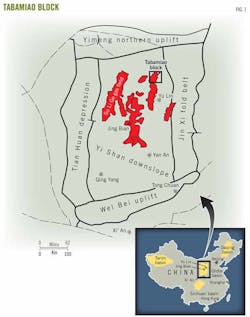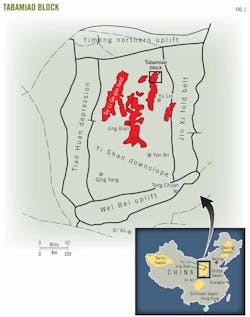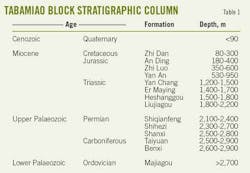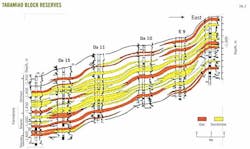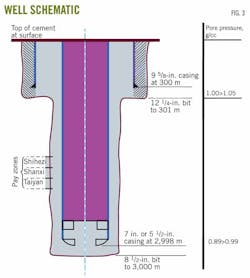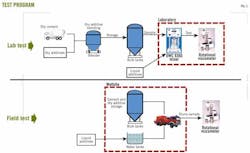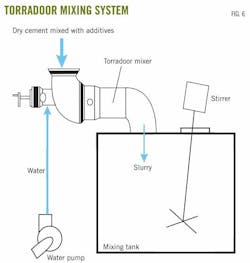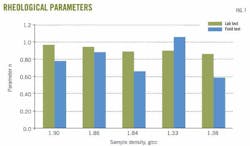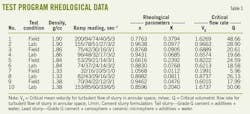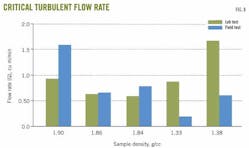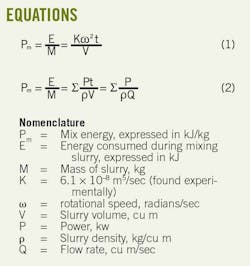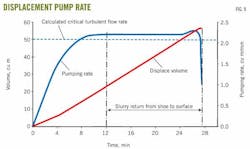Jian Song
Gonghu Liu
Yan Jin
Mian Chen
China University of Petroleum
Beijing
Optimization of the displacement flow rate improved the cement bonding of Tabamiao block's gas exploration wells in the Ordos basin of north central China.
Tests indicated that the mixing energy determined in a laboratory was less than the mixing energy in a cementing unit during a pump job, resulting in a different cement slurry flow regime.
Good cement bonds for preventing gas migration require the removal of mud, and the flow regime of cement slurry in an annular space is one key factor for good mud removal.
The displacement of drilling mud improves if the cement slurry in the well's annulus is in turbulent flow.
Tabamiao block
The Tabamiao block is in the north part of the Yi Shan slope (Fig. 1). The block has low porosity, low permeability, and compacted sandstones.
A yearend 2004 study estimated the block held 555 million cu m of resources and 260 billion cu m of proved reserves.
The Taiyuan, Shihezi, and Shanxi formations are gas bearing (Table 1) and form a complete sedimentary sequence of marine tidal flats to paralic-delta terrestrial braided channels.
The sequence has a 250-80 m thickness and stable lateral block-shaped commercial gas pools. A dual tight sealing lithology and anomalous pressure in the regional cap rock of the upper Shihezi formation confine the gas.
Layered lithologic traps overlap, and the hydrocarbon reservoirs are characterized by near source and block-like traps (Fig. 2).1 The area has three kinds of hydrocarbon source rocks: coal beds, dark claystone, and limestone.
Cementing operations
Average well depth in the Tabamiao block is 3,000 m; Fig. 3 illustrates a typical well completion.
Well completion included drilling a 121⁄4-in. hole to about 301 m and setting 95⁄8-in. surface casing at 300 m to isolate soft formations and to allow installation of the blowout preventers.
Drilled next was an 81⁄2-in. hole to about 3,000 m. Set in this section was either 7-in. or 51⁄2-in. production casing.
Mud used to TD was a potassium-ammonium polymer drilling fluid. Table 2 shows the mud density.
Pore pressure was as low as 0.89-0.99 g/cc in the Paleocene formation, and the fracture pressure varied in different areas and was as low as 1.45 g/cc in some boreholes.
The cement slurry for isolating all the annular space and preventing losses was a dual-density slurry. The lead cement slurry had a low density, while the tail slurry for sealing the pay zones had about a 1.85 g/cc density. Fig. 4 shows the pressure in the borehole and location of the cement slurry in the annular space.
After about 20 wells were drilled and completed in first-half 2003, it was noted that the wells often had poor cement bonding. Some well tests could not even be conducted because of poor isolation.
The poor bonding quality blocked further gas exploration in the Tabamiao block.
Research to determine the cause of the bonding problem studied factors that affect bonding quality, especially the rheological behavior of the cement slurry during displacement. The program looked at mixing procedures, cement additives, and optimized mud conditions.
Mixing energy
Cementing operations rely on the rheological properties as determined on the cement slurry mixed in a laboratory. Rheological properties depend on how much energy is used to mix the slurry.2
In a laboratory, mixing of the cement slurry is at up to 12,000 rpm, as per API Specification 10A. At the wellsite, however, cementing units mix the slurry at a much lower rate.
The different mixing rates produce a variance in rheological properties. A test program verified the effect of mixing energy on rheological behavior.
To improve drilling fluid displacement in the annulus, the job must pump the cement slurry in turbulent flow, as determined from field test data.
Test program
The test program used a OWC-9360 constant speed mixer, rotational viscometer, and GJC 35-16 cementing trucks. The slurry in the laboratory and at the wellsite had the same formulation.
Data from the laboratory tests compared with the field indicated different properties for the slurry.
The laboratory test used samples from the bulk tanks that held neat dry cement already blended with dry-additives. After the addition of water and liquid additives, according to API-10A, the mixer maintained 4,000 rpm before addition of dry additives in no more than 15 sec.
After all material was in the mixer, the mixing rate was increased to 12,000 rpm for 35 sec, followed by conditioning the samples in an atmospheric consistometer and then obtaining rheological parameters with a rotational viscometer. Fig. 5 illustrates the test setup.
On the rig site, a GJC 35-16 cementing truck mixed water and cement blended with dry additives stored in bulk tanks to make the cement slurry with a Torradoor mixing system (Fig. 6). Samples from the mix tank were stirred and conditioned in a atmospheric consistometer before a rotational viscometer measured the rheological properties.
The test program included 10 samples; 5 from the lab and 5 from the wellsite. Table 3 and Figs. 7 and 8 show the test data from the laboratory and rig site that indicate different slurry properties even though samples from both used the same material.
The calculated critical turbulent flow rate was for a 81⁄2-in. hole with a 10% enlargement and 7-in. casing.
Mixing energy may affect the rheological parameters of slurry.3 Different mixing rates produce different mixing energies.
Mixing-energy calculations
Equation 1 in the equation box calculates the energy per mass of slurry during time t for the laboratory test (Table 3).3
On the wellsite, the mixing energy is the sum of the mechanical work provided by flow through a mixing and pump system. Reference 3 defined the total mechanical energy as Equation 2.
Table 4 shows the mixing energy for different slurry densities. From the data in Table 4, one conclusion is that mixing energy of a cementing unit, such as GJC 35-16, is somewhat higher than from the mixer in the laboratory. A different mixing energy results in different behavior of the cement slurry.
For common density slurries, such as 1.84, 1.86, and 1.90 g/cc, it is more difficult for slurries mixed by cementing units to be in turbulent flow. But the contrary is true for low-density slurries such as 1.33 and 1.38 g/cc.
Optimized flow regime
A field test also was conducted on every pumping job to determine cement slurry rheological parameters pumped by the cementing units at the rig site to verify the actual turbulent flow rate.
The pumping rate during mud displacement should not be lower than the critical turbulent flow rate calculated from the field tests.
Fig. 9 shows the pumping rate during the displacement.
The field test data provided the pumping rate for the cement slurry to be in turbulent flow.
The use of data from the field tests improved cement bonding quality. Table 5 shows the bonding improvement quality, with 90% of the wells after the test having excellent bonding.
References
1. Hao Shumin, Hui Kuanyang, and Li Liang, "Reservoir features of the Daniudi low-permeability gas field in Ordos basin and its exploration and development technologies," Oil and Gas Geology [in Chinese], Vol. 27, No. 6, pp. 762-68.
2. Devereux, S., Drilling Technology, Tulsa: PennWell Corp., 1999.
3. Nelson, E.B., Well Cementing, New York: Elsevier, 1990.
The authors
More Oil & Gas Journal Current Issue Articles
More Oil & Gas Journal Archives Issue Articles
View Oil and Gas Articles on PennEnergy.com
